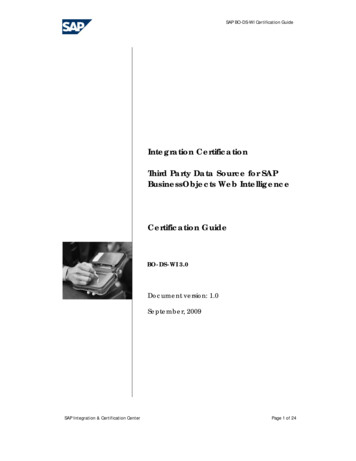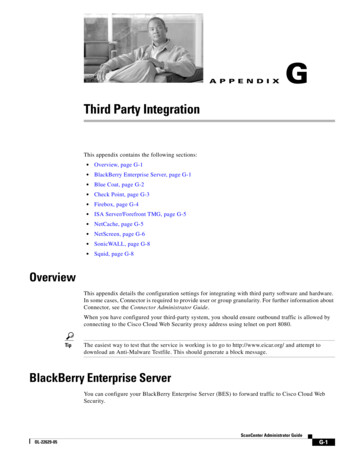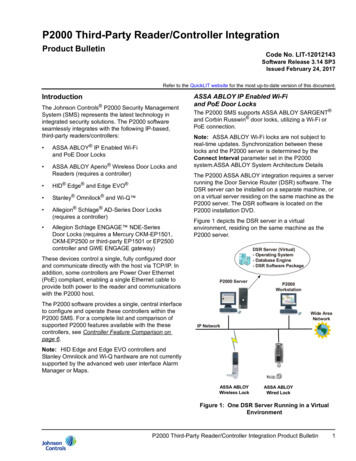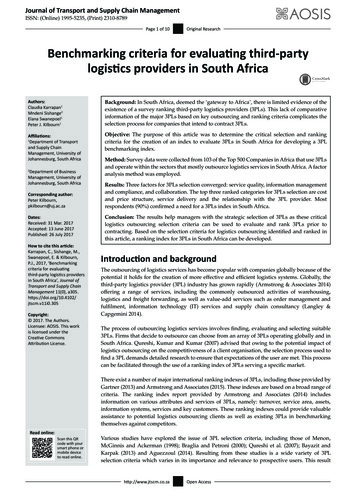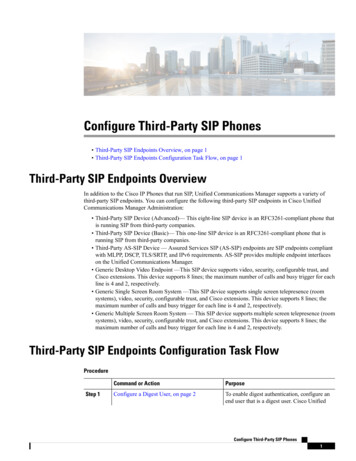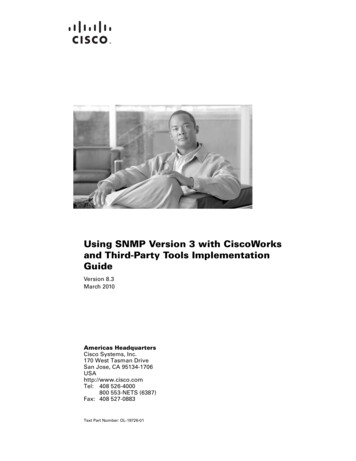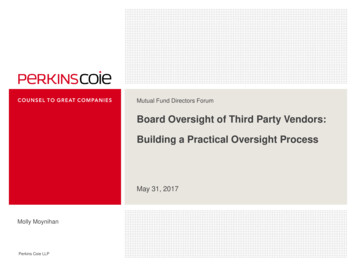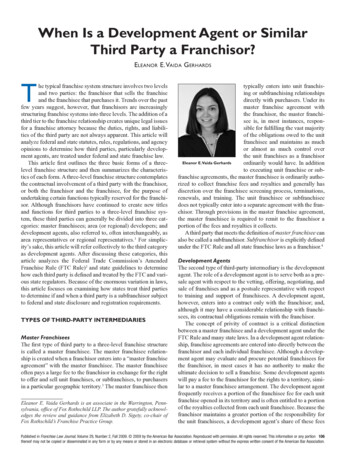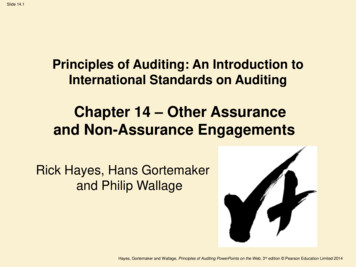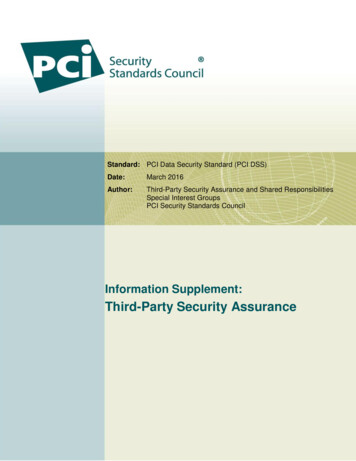
Transcription
Standard: PCI Data Security Standard (PCI DSS)Date:March 2016Author:Third-Party Security Assurance and Shared ResponsibilitiesSpecial Interest GroupsPCI Security Standards CouncilInformation Supplement:Third-Party Security Assurance
Information Supplement Third-Party Security Assurance March 2016Document ChangesDateDocument VersionDescriptionAugust 20141.0Initial releaseMarch 20161.1Expanded and revisedcontent based upon theShared ResponsibilitiesSpecial Interest GroupPagesAllVariousThe intent of this document is to provide supplemental information. Information provided here does notreplace or supersede requirements in any PCI SSC Standard.i
Information Supplement Third-Party Security Assurance March 2016Table of ContentsDocument Changes . i1Introduction . 11.11.2Intended Use . 2Terminology . 21.3Audience. 22Examples of Third-Party Service Providers . 43Third-Party Service Provider Due Diligence. 53.1 Determining the Scope of the Services Provided . 63.2 Due Diligence Research of the Third-Party Service Provider . 63.2.1 Acquirer/Payment Card Brands . 93.2.2 Third-Party Service Provider Validation Documentation . 93.2.3 Payment Card Brand Validated Providers Lists and Websites .123.33.44Perform Risk Assessment .13Documenting Results .15Engaging the Third-Party Service Provider.164.14.2Non-Disclosure Agreement (NDA) .16Set Expectations .164.34.44.54.64.74.8Gain Transparency.17Establish Communications .17Request Evidence .18Obtain Information about PCI DSS Compliance .18Frequency of Review.18Mapping of Third-Party Services to Applicable PCI DSS Requirements .195Written Agreements, Policies, and Procedures .205.1 Agreements between PCI DSS Compliant Third-Party Service Providers versus non-PCI DSSCompliant Third-Party Service Providers .205.2 Considerations when Building Agreements, Policies, and Procedures .215.3 Additional Considerations .235.3.1 Responsibility Matrix .235.3.2 Data Breaches .245.3.3 Post-termination Considerations Regarding TPSPs and their Customers .245.3.4 Outsourcing of Provided Functionality (Nested TPSPs) .255.3.5 Loss of Compliance Status .266Maintaining Relationships with and Monitoring Third-Party Service Providers.276.1 Developing a Third-party Service Provider Monitoring Program .276.1.1 Cardholder Data Environment (CDE) Scope Definition .286.1.2 Maintaining an Inventory of Third-Party Service Providers .286.1.3 Third-party Service Provider Monitoring Procedure .28The intent of this document is to provide supplemental information. Information provided here does notreplace or supersede requirements in any PCI SSC Standard.ii
Information Supplement Third-Party Security Assurance March 20166.2 Other Considerations .306.2.1 Third-party Service Provider Does Not Provide Requested Information .306.2.2 Third-party Service Provider has not Validated PCI DSS Compliance.306.2.3 Third-party Service Provider Validates PCI DSS Compliance via Inclusion within the Entity’s PCIDSS Assessment .316.2.4 Existing or New Service or Process is not PCI DSS Compliant or will make the Entity or TPSP nonPCI DSS Compliant .32Appendix A:High-Level Discussion Points for Determining Responsibility .34Appendix B:Sample PCI DSS Responsibility Matrix .43Acknowledgement .45About the PCI Security Standards Council .48The intent of this document is to provide supplemental information. Information provided here does notreplace or supersede requirements in any PCI SSC Standard.iii
Information Supplement Third-Party Security Assurance March 20161 IntroductionAs entities work toward the goal of achieving and maintaining ongoing PCI DSS compliance, they maychoose to leverage third-party service providers (TPSPs) to achieve their objectives. Entities can use a TPSPto store, process, or transmit cardholder data on the entity’s behalf, or to manage components of the entity’scardholder data environment (CDE), such as routers, firewalls, databases, physical security, and/or servers.These TPSPs can become an integral part of the entity’s cardholder data environment and impact an entity’sPCI DSS compliance, as well as the security of the cardholder data environment.The use of a TPSP, however, does not relieve the entity of ultimate responsibility for its own PCI DSScompliance, or exempt the entity from accountability and obligation for ensuring that its cardholder data(CHD) and CDE are secure. Clear policies and procedures should therefore be established between the entityand its TPSP(s) for all applicable security requirements, and proper measures should be developed tomanage and report on the requirements.A robust and properly implemented third-party assurance program assists an entity in ensuring that the dataand systems it entrusts to TPSPs are maintained in a secure and compliant manner. Proper due diligenceand risk analysis are critical components in the selection of any TPSP.This guidance focuses primarily on the following:Third-Party Service Provider Due Diligence: Thorough vetting of candidates through careful due diligence,prior to establishing a relationship, assists entities in reviewing and selecting TPSPs with skills andexperience appropriate for the engagement.Service Correlation to PCI DSS Requirements: Understanding how the services provided by TPSPscorrespond to the applicable PCI DSS requirements assists the entity in determining the potential securityimpact of utilizing TPSPs on the entity’s cardholder data environment. This information can also be used todetermine and understand which of the PCI DSS requirements will apply to and be satisfied by the TPSP, andwhich will apply to and be met by the entity.Note: Ultimate responsibility for compliance resides with the entity, regardless of how specific responsibilitiesmay be allocated between an entity and its TPSP(s).Written Agreements and Policies and Procedures: Detailed written agreements promote consistency andmutual understanding between the organization and its TPSP(s) concerning their respective responsibilitiesand obligations with respect to PCI DSS compliance requirements.Monitor Third-Party Service Provider Compliance Status: Knowing the TPSP’s PCI DSS compliancestatus helps to provide the organization engaging a TPSP with assurance and awareness about whether theTPSP complies with the applicable requirements for the services provided. If the TPSP offers a variety ofservices, this knowledge will assist the entity in determining which TPSP services will be in scope for theentity’s PCI DSS assessment.The intent of this document is to provide supplemental information. Information provided here does notreplace or supersede requirements in any PCI SSC Standard.1
Information Supplement Third-Party Security Assurance March 20161.1Intended UseThe intent of this information supplement is to provide guidance to entities engaging TPSPs with whom CHDis shared or that could impact the security of CHD, as required by PCI DSS Requirement 12.81. Thisadditional guidance for PCI DSS Requirement 12.81 is intended to assist entities and TPSPs betterunderstand their respective roles in meeting this requirement.The information in this document is intended as supplemental guidance and does not supersede, replace, orextend PCI DSS requirements. Ultimately, the entity is responsible for ensuring its own PCI DSS compliance,whether or not a TPSP is involved. How responsibilities are allocated between an entity and its TPSP(s) oftendepends on the specific relationship and services being provided. This guidance does not replace proper riskassessment, and compliance with the guidance does not guarantee compliance with Requirement 12.81, etc.1.2TerminologyThe following terms are used throughout this document: Entity – An entity is any organization that has the responsibility to protect card data and may leveragea third-party service provider to support them in card-processing activities or to secure card data. TPSP (Third-party Service Provider) – As defined in the PCI DSS and PA-DSS Glossary of Terms,Abbreviations, and Acronyms, a service provider is a business entity that is not a payment brand,directly involved in the processing, storage, or transmission of cardholder data on behalf of anotherentity. This also includes companies that provide services that control or could impact the security ofcardholder data. There are many types of businesses that could fall into the category of “serviceprovider,” dependent on the services provided. Most commonly, a TPSP could be a legally separateentity; but it can also be a separate business unit or component of the entity under assessment—forexample, an internal service provider—where the provider is outside the direct management control ofthe entity assessed. Nested or Chained TPSP – A nested or chained TPSP is any entity that is contracted for its servicesby another third-party service provider for the purposes of providing a service.1.3AudienceEntities Engaging a Third-Party Service Provider (for example, issuers, merchants, acquirers, or otherservice providers) – Entities that engage TPSPs for the storage, transmission, processing of cardholder data,or otherwise provision of services that control or may impact the security of cardholder data may benefit fromthese guidelines. The recommendations provided in this document are intended to assist entities indeveloping an increased understanding regarding utilization of TPSPs and the subsequent impact to theentity’s cardholder data environment, the impact to the entity’s own PCI DSS compliance responsibilities, aswell as provide guidance on how to meet the intent of PCI DSS Requirement 12.81 governing TPSPs.1This reference is to PCI DSS v3.1 – April 2015The intent of this document is to provide supplemental information. Information provided here does notreplace or supersede requirements in any PCI SSC Standard.2
Information Supplement Third-Party Security Assurance March 2016Third-Party Service Providers – This guidance document may also provide useful information for TPSPs inunderstanding the responsibilities of TPSPs to the entities for which the TPSPs are providing services. Inaddition, a TPSP may be dependent on the compliance of a nested or chained TPSP to achieve overallcompliance of a service. The TPSP should understand how best to engage with its partner(s) to ensure PCIDSS compliance of the services being offered. PCI DSS Requirement 12.92 also requires service providers toacknowledge in writing to the TPSP’s customers its responsibilities for securing the customers’ cardholderdata or the customers’ cardholder data environment.Acquirers (also known as “acquiring banks,” “merchant banks,” or “acquiring financial institutions”) – As anentity that initiates and maintains relationships with merchants for the acceptance of payment cards, anacquirer is responsible for ensuring that the merchants in its portfolio are using secure TPSPs.2This reference is to PCI DSS v3.1 – April 2015The intent of this document is to provide supplemental information. Information provided here does notreplace or supersede requirements in any PCI SSC Standard.3
Information Supplement Third-Party Security Assurance March 20162 Examples of Third-Party Service ProvidersBelow are examples of types of services and providers with which an entity may work: Organizations involved in the storage, processing, and/or transmission of cardholder data (CHD). Thirdparty service providers in this category may include: Entities providing call center and customer contact services E-commerce payment providers Organizations that process payments on behalf of the entity, such as a partner or reseller Fraud verification services, credit reporting services, collection agencies Third-party processors Entities offering processing-gateway services Third-party debt collectors/collection processesOrganizations involved in securing cardholder data. TPSPs in this category may include: Companies providing secure destruction of electronic and physical media Secure storage facilities for electronic and physical media Companies that transform cardholder data with tokenization or encryption E-commerce or mobile-application third parties that provide software as a service Key-management providers such as key-injection services or encryption-support organizations(ESO) Point-of-sale companies (or integrators/resellers) involved with installation, maintenance, monitoring, orotherwise support of their systems. Organizations involved in the protection of the cardholder data environment (CDE). TPSPs in thiscategory may include: Infrastructure service providers Managed firewall/router providers Secure data-center hosting providers Monitoring services for critical security alerts such as intrusion-detection systems (IDS), antivirus, change-detection, compliance monitoring, audit-log monitoring, etc.Organizations that may have incidental access to CHD or the CDE. Incidental access is access thatmay happen as a consequence of the activity or job. TPSPs in this category may include: Providers of managed IT delivery channels and services Companies providing software development, such as web applications Providers of maintenance services—for example, HVAC or cleaning servicesThe intent of this document is to provide supplemental information. Information provided here does notreplace or supersede requirements in any PCI SSC Standard.4
Information Supplement Third-Party Security Assurance March 20163 Third-Party Service Provider Due DiligencePartnering with the right TPSPs is a challenging task. Initial considerations should include measures to protect cardholder data, financial data,and other sensitive and personal data, and complying with local laws and regulations. Each organization should develop its own policies andprocedures, as well as its own criteria for pre-selecting and managing potential TPSPs during the vetting process. All efforts should be placedon exerting the appropriate amount of due diligence and performing a risk assessment of pre-selected TPSPs. Below is an example of a highlevel process flow that an entity may include as part of its due diligence when engaging TPSPs. Please note this process is not exhaustive. Itis meant as a guideline to assist organizations in creating an appropriate due diligence program to engage TPSPs.Figure 1: High-level TPSP Engagement ProcessThe intent of this document is to provide supplemental information. Information provided here does notreplace or supersede requirements in any PCI SSC Standard.5
Information Supplement Third-Party Security Assurance March 20163.1Determining the Scope of the Services ProvidedWhen engaging a TPSP, initially, the entity should consider determining the scope of the TPSP'sinvolvement with regard to storing, processing, or transmission of cardholder data and the resulting effecton the security of the CDE. Because TPSP involvement and services may impact the level of riskassumed by the entity when processing payment transactions, thorough due diligence is critical indetermining which TPSP is appropriate and which third-party services may be needed.Defining the level of involvement of a TPSP is crucial to understanding the overall risk assumed by theentity related to PCI DSS compliance. The entity may elect to engage an outside party to assist with theassessment of the scope of services to be provided by the TPSP and the applicability of those services tothe entity’s PCI DSS compliance. Questions that may help with this process include: Given the current payment ecosystem and payment ch
PCI DSS compliance, as well as the security of the cardholder data environment. The use of a TPSP, however, does not relieve the entity of ultimate responsibility for its own PCI DSS compliance, or exempt the entity f
